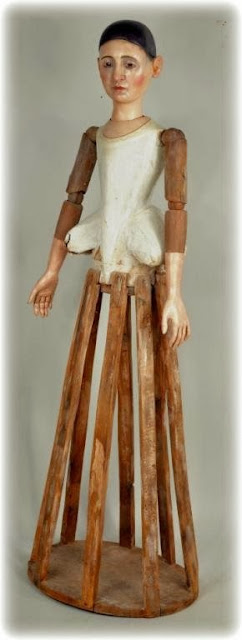So we have talked about the progression of design of Santos from the primitive style to more elaborate costumed pieces.
For this posting, I would like to share with you how my inherent interest of the Santos have been a part of me...in my blood...in my heart...
I was raised Lutheran-not Catholic, but have always found the Madonna to speak to me- for some reason...
Many years ago, Mark and I were headed back from Santa Fe and we stopped at a roadside Mexican restaurant for lunch. We were seated and across the room I spotted a painting. As I was eating lunch I kept looking at the painting...finally I said to Mark I just can't seem to take my eyes off that painting. My sweet husband told me to go over and check out how much it was, my reply was even if it was $500, I still really wanted it.
I got up and walked over to look at the little tag next to it...I came back smiling and told Mark that we needed to add another "0" to that! We got up and left.
SOoo, for the next year, I thought about that painting, endlessly. And we did some research on the artist Miguel Martinez and found that we (I) still really loved that painting a year later.
We found ourselves back in Santa Fe and stopped by the Taos gallery to purchase the painting (giclee). I was thrilled and today, some 15+ years later, I still love this painting. Why it spoke to me has become even clearer in these past two years.

Below is a painting from a Russian painter. I love the gold circle and the print on it behind her...
 This is a traditional painting of Mary, I love the tenderness of it...still the gold halo.
This is a traditional painting of Mary, I love the tenderness of it...still the gold halo.
And how could I have not put this one in this collection? The Asian Madonna!
Below is another traditional painting. I so love the long fingers and toes that to me, add such a gracefulness to her.
The shape of the face, long nose, soft eyes...very lovely.
And now we move to the how this all ties together!
When I was growing up, I did not have Grandparents, Aunts and Uncles, or cousins. I so wanted to have family like all my friends. Maybe that is why I became so entranced with my art to create an extended family by sharing my gifts.
I did know that my Dad was first born Danish and never really knew where my Mom came from. I have discovered that is her story to tell or not. So I was left on my own to discover my family roots.
In the last few years, we did need to find some documentation for my Mom, which entailed hiring a lawyer to track down any family...
They did find a cousin from my Mom's half sister! Mary. (are you getting the connection with Mary from the Madonna??) We now have been cousins for 2 years and I am so thrilled- it is my only relative outside my immediate family and it is the first time in my life that I have been able to call someone Cousin!
 |
| My sister Robin, My Mom, me, Cousin Mary |
As Mark and I drive back and forth to Santa Fe, we head straight south/north. One year, coming back we jogged over from the highway and took a side road.
At twilight, we came around a bin in the Sangre De Cristo mountain range and I looked over to the east a saw a glow from a small town, I asked Mark what that town was...La Veta. I told him that there was something about it, some draw for me. This whole section of southern Colorado is home to me.
Now we jump forward again 10+ years to finding cousin Mary. I found out that my Mom's side of the family comes from that part of the Colorado.
Mary was a gold mine, she was able to fill in so many of the blanks. I thought I would never know who my Grandmother was or any other family!
 |
| This is a great photo from the 1930's of my Grandmother, Ignasita on the far right and her Mother in the center |
My family roots hale from Walsenburg, La Veta and Trinadad.
 |
| Cousin Mary and me! |
Last summer, Mark and I met Cousin Mary and her husband, Ricky, in La Veta and
we traveled around to see the family (ok- the graves of the family) but I
was still so happy to have landed...to have roots.
 |
| At Grandma Ignasita grave site. |
From Cousin Mary, I have found out that the Medina and Vigil women loved fashion and loved to create things, many sewed!
Now, this all brings together my longing to create a Madonna-type piece...my love of the Santos, the bond with southern Colorado, the love of sewing and working with your hands...and probably the most important- my love of sharing with you- my extended family...
Next week, the final posting of Alma Benita including Inspiration and Alma herself!






























dibs.jpg)
dibs.jpg)










